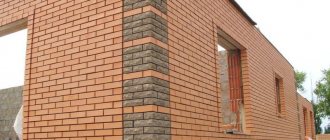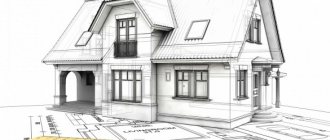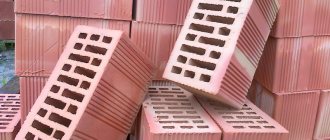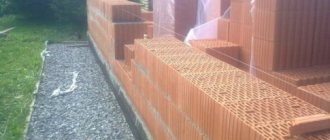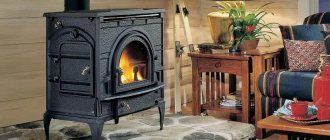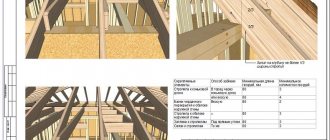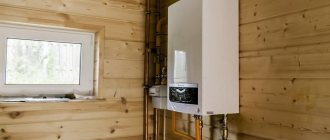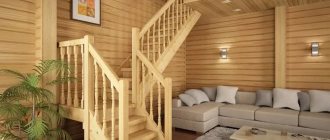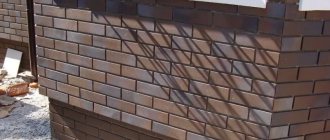Porous brick is not ideal, but its distribution in Europe and Russia has nothing to do with some disadvantages. In most cases, they are subjective and based on the private opinions of users.
Building a house from porous bricks also has a number of features that should be taken into account, ranging from a well-designed project to the qualification level of the builders. By contacting our specialists, you can quickly and efficiently build a turnkey brick house. Many years of experience in the construction of cottages and private houses allows the InnovaStroy team to create structures of any complexity from the material you choose.
Nuances of technology and application
Slotted bricks are produced with minimal consumption of primary raw materials. This reduces labor intensity and helps reduce the cost of the finished product. The seven-slit building block has become widespread, but any other number of voids can be obtained without any problems. Clay with a moisture content of 10% is used for work.
Obtaining voids inside the pressing block is achieved by using special cores. An important point is the systematic drying of the blocks, which should not be accelerated. Once drying is complete, the bricks are fired, heating them to 1000 degrees. Slotted brick is suitable primarily for load-bearing walls; a plinth cannot be laid from it. But you can lay out the internal walls.
The selection of blocks by size takes into account the complexity of construction and the scale of the upcoming work. The larger the structure being built, the larger the blocks themselves should be. This allows you to speed up the work process and save on cement mixture. Large residential buildings are often built from double smooth bricks. The ban on the use of hollow bricks in plinths and foundations is due to its high hygroscopicity.
Savings in numbers
The average retail cost of such a block is 40 rubles. The savings from home production are obvious and if you need to build a house that will take 8,000 blocks, you can save 80,000 rubles. But the house always needs a garage, a bathhouse, outbuildings, and the purchased equipment will not stand idle. We can conclude that making bricks with your own hands is a profitable business, which, in addition to benefiting your own household, will bring profit from sales.
Also, it is worth considering that in order to save money, you can regulate the quality of products and prevent overconsumption of expensive material. For example, a two-story house requires 10,000 building blocks. The first floor will bear a large load and it is better to lay it out of a high-grade block made of structural expanded clay (expanded clay gravel) or crushed stone. The best option for the second floor would be a block made of cheaper thermal expanded clay (expanded clay crushed stone).
The best option for partitions and interior walls is crushed stone. Such walls have increased sound insulation and hold anchors well for hanging furniture, household appliances, and electronics. The combined use of various types of filler for the construction of one object will improve the quality of construction and save up to 30,000 rubles for every 10,000 blocks.
Source
Advantages of slotted bricks
Today, hollow building material is a sales leader due to its advantages:
Installation of slotted bricks.
- Low thermal conductivity. This characteristic is one of the most important, because the comfort of the building and heating costs depend on it. In addition, during construction there will be no need to additionally insulate the walls, which will reduce costs.
- Strength. Thanks to high strength indicators, not only the quality of erected structures improves, but also their service life increases. On average, a slotted double brick lasts 50 years.
- Noise insulation. Hollow blocks protect rooms well from noise, because... the free space in the material filled with air acts as a shield that prevents the spread of sounds.
- Saving. During construction work, slotted bricks and cement mortar are consumed more economically than when using solid blocks. In addition, with the help of such material, the process of constructing structures moves much faster, especially if one-and-a-half or double products are used. Don’t forget about the price of bricks - it is much lower, which makes it possible to reduce the cost of construction.
The use of porous blocks in the construction of residential buildings
If you use the material described in the article, you can build a house that will be reliable and durable. The products can withstand a load of 150 kilograms per square centimeter. It is this characteristic that allows you to build buildings whose height is equivalent to 9 floors. Thanks to this strength, porous bricks can be used in any type of construction.
The manufacturer made sure that the blocks have the most convenient dimensions; they differ from ordinary bricks. On sale you can find products of various sizes, the thickness of the walls will be 250 millimeters. The speed of construction can be compared with the speed that can be achieved when using gas blocks. One team of builders, even without professional experience, will be able to build a building box using the described brick in one week.
What are the advantages of double brick walls
Brickwork schemes.
If we take into account the increased heat capacity and compare 2 types of walls by heat capacity (single and double), we get the following. When considering these types, it can be noted that double brick laying provides greater heat capacity
This is primarily due to the reduced number of seams between elements. This difference is due to the increased heat capacity of the hollow brick.
But a double brick wall can be considered more productive. It is also necessary to take into account the fact that when the voids are fastened with mortar and improved adhesion of the masonry, even greater thermal conductivity of such a structure is ensured. And first of all, the strength of the wall increases; such adhesion practically erases the chance of microcracks appearing between individual elements.
From all that has been said, we can identify the conditions under which it would be more rational to use this type of masonry and this material. Do not forget that the wall itself can be built either from ceramic stone or silicate stone. Each of them also has its own advantages.
Ceramics are universal, have all the properties necessary for construction in any conditions, while construction is possible both as a foundation and as a building itself. But there is one drawback: such material is very expensive. Silicate products are characterized by lower cost, high strength, good sound insulation and attractive appearance.
But such material is afraid of fire and moisture. Therefore, it is most suitable for exterior decoration and the construction of load-bearing walls on top of the foundation. At the same time, ceramics can be used anywhere and everywhere, but this will significantly increase the construction cost.
//www.youtube.com/watch?v=ozo35gI9RZs
Taking into account the above, several main factors can be identified. The construction of such walls is much more profitable, faster and more economical in contrast to standard single ones
Wallpaper for brickwork in the interior of different rooms - photo
This type of finishing will not look good in all rooms; in some of them it is used with reservations. Let's look at each case in more detail.
Brick wallpaper in the living room
Wallpaper with a pattern is recommended for use in spacious rooms. Here they can highlight an accent wall or help with zoning. At the same time, neighboring surfaces must be neutral, otherwise the interior will turn out to be too colorful.
Such a covering in the living room dictates a certain style, which has its own requirements for content. The furniture should be modern, possibly leather. It is better to exclude artificial materials from the interior. Wooden details will favorably emphasize the “masonry”.
The color palette depends on the shade of the walls. So, white brick goes well with any color. Red brick harmonizes with restrained and natural shades.
Designers recommend limiting yourself to central lighting, since side sources will emphasize the artificial origin of the masonry.
Brick wallpaper in the kitchen interior
The kitchen area is very demanding on the quality of finishing materials. In conditions of constant humidity, sudden temperature changes and high levels of pollution, paper wallpaper will not last long.
Vinyl and non-woven fabric cope best with this difficult task, so when covering walls it is recommended to focus on them.
The design of the kitchen depends on its size and layout. If there is a dining area, then “brick” wallpaper should be pasted there, thereby marking the boundaries. In small kitchens, they can be glued to the entire working wall or just to the apron, hidden behind a glass cover for safety.
Against the background of white brick, light wood furniture with bright details looks good. Against the background of red, calm and cool shades look better.
Brick wallpaper in the bedroom interior
In the bedroom, such decor should be used with extreme caution. Often only one wall of the room is decorated, the one to which the bed adjoins.
The rough surface can be balanced with light curtains, a blanket or a beautiful bedspread. A stone wall is ideal for displaying paintings, especially when it comes to contemporary art.
With the help of patterned decoration, you can separate the sleeping area from other areas: with a desk, chest of drawers, mirror or dressing table.
Brick wallpaper in the hallway
This is the most ideal place for them. An important point is to choose this style for all other rooms and premises.
- Wallpaper in the hallway under white brickwork is more suitable for a narrow, elongated area.
- This color palette helps to visually expand the boundaries of space.
- In such cases, it is better to choose furniture in lighter colors. This is the only way to enhance the desired stylistic effect.
Brick wallpaper options for a children's room
A controversial decision is to decorate the room where the children are with brick. Such an interior is unlikely to suit small children. But older children may like this style. The brick walls will remind them of a castle or underground catacombs.
A big plus of the coating is that it is safe and pleasant to the touch.
For a teenager, such an unusual finish will be especially attractive. Such a wall is suitable for posters, paintings with abstractions and all kinds of photographs of idols.
Brick wallpaper on the balcony
Loggias and balconies seem suitable for brick finishing. However, given the constant fluctuations in temperature, humidity, exposure to sunlight and other atmospheric phenomena, it is recommended to use non-woven or vinyl products in such places.
Bathroom with brick wallpaper
The walls in the bathroom can be covered with moisture-resistant wallpaper with imitation brickwork. Places of direct contact with water should be avoided; it is better to cover them with tiles or plastic panels.
Scope of application of hollow bricks
Slotted brick is intended for the construction of load-bearing walls, but it is also used to create internal partitions.
The size of the blocks will depend on the type of structure, for example, for main walls it is better to use double bricks, and for lightweight buildings single products are suitable
But it is important to know that structures such as a foundation or plinth should not be constructed using hollow blocks, since moisture will accumulate in them, and soon the material will begin to collapse
To create interior partitions or other objects that are not load-bearing, you can use economical cement-sand bricks. If you plan to install a stove or fireplace in your home, then you should give preference to diatomine foam blocks.
As for facing work, ceramic or porous material can be used to perform it.
Additional Information
Interior partitions, as well as other non-load-bearing structures, are often constructed from cement-sand bricks. The lining of stoves and fireplaces is mainly made with diatomite foam structures. But cladding is most often done with porous or ceramic material. According to established standards, the minimum proportion of voids in slotted bricks cannot be less than 13%. The term covers ceramic products made from various types of low-melting clay.
The slot material of the European format has dimensions of 250x85x65 mm, and its weight is limited to 2 kg. To build load-bearing structures, bricks of grades M125-M200 are used. For partitions, blocks with a strength of at least M100 are required. The lines of most Russian factories include slotted ceramic bricks with a strength of M150 and higher. Ordinary material should have a density of 1000 to 1450 kg per 1 cubic meter. m, and facing - 130-1450 kg per 1 cubic meter. m.
The minimum permissible resistance to cold is not less than 25 cycles of freezing and defrosting, and the water absorption coefficient is not less than 6 and not higher than 12%. As for the level of thermal conductivity, it is determined by the number of voids and the density of the product. The normal range is 0.3-0.5 W/m°C. The use of blocks with such characteristics will reduce the thickness of external walls by 1/3. There is only one warmer material - this is especially lightweight insulated ceramics.
Slit clinker is mostly made in the form of double stone. This building material makes it possible not to use auxiliary insulation products for walls with a thickness of 25 cm or more and for internal partitions. The increased thickness of the blocks ensures, along with faster work, a minimal risk of displacement of structures. This further minimizes the pressure on the base of the building. The products survive even direct exposure to an open flame well.
In some cases, slotted brick laying is done using special anchors. Screw-type fasteners (with an additional nut) are suitable. In appearance, it is a steel rod 0.6-2.4 cm long. The coupling on such products is movable, and the shank looks like a cone. The main surface is coated with a layer of zinc.
Driven-in anchors (with the addition of spacer sleeves) are mainly made of brass. In addition to the sleeve, the design includes a nut and a bolt. The shape of the bolt can vary extremely widely. A chemical anchor is also used, which works through a mixture of two components. The fastener is held in the masonry by a nylon sleeve.
You will learn more about slotted bricks from the video below.
Consumables
The consumables you will need are: cement grade M 400 or M 500, construction sand, filler, plasticizer C3. There are no problems with purchasing a plasticizer. It is sold in places where cement is sold or where material for making paving slabs is sold. Separately, it is worth considering the filler, or as it can also be called: the main component of the block.
In different regions, there are different types of fillers used in the production of concrete products. In regions where clay is available, expanded clay is common. In places where a lot of coal is used, slag is present in large quantities. Also, throughout the country you can easily buy crushed stone or screenings. In some cases, broken bricks and concrete chips are used to produce concrete products.
The filler should be selected according to the intended use of the brick. If the goal is to make the building warm, then slag is perfect. But such a block is suitable only for one-story buildings with a light roof, since slag is a lightweight material, has air pores and cannot bear a large load. If you choose expanded clay as a filler, then you should buy only structural, fine-grained expanded clay. It is capable of bearing loads and can be used to build buildings up to three floors.
In cases where the building has a height of up to five floors and is equipped with concrete floors, it is necessary to produce the block using crushed stone. Crushed stone of fraction 5 - 10, or 10 - 20 mm is suitable for these purposes. Such a product will be much heavier than a block made of expanded clay or slag, but it is worth considering that it will be subject to a greater load.
Classification of Hollow Bricks
In the modern world, the following types of hollow bricks are distinguished according to the shape of the holes in them:
- with oval holes;
- with round ones;
- with square;
- with rectangular ones.
The material is also divided into types according to purpose:
- if there is a relief pattern on the building material, then it can be used for the construction of decorative fences;
- building material with beveled corners or rounded edges is used for the construction of vaulted structures and arrangement of arched passages.
Hollow bricks are made using various firing technologies:
- in ring furnaces;
- in tunnel kilns.
This building material is made from various raw materials:
- clay;
- cement.
Characteristics of hollow bricks, according to which the material is also divided into groups:
- thermal conductivity coefficient of hollow bricks, a low indicator is achieved due to the presence of cavities in the building material;
- firing temperature;
- degree of porosity.
Hollow bricks are divided into groups according to the method and material of manufacture:
Porous. This building material is used for facing work. The porous structure significantly reduces the weight of hollow bricks. Among the advantages are high rates of thermal insulation and sound absorption.
Double porous brick
Thermally efficient. This material allows you to significantly save money on construction. Its thermal insulation properties allow it to be laid not in two, but in one row. The relatively low weight of the building material significantly lightens the wall structures, which in turn place less load on the base of the building. Maintains the required temperature in the home both in winter and summer.
Thermally efficient hollow brick
Cement-sand. As the name implies, cement, sand and various binding components are used to make this material. Since clay is not needed for its production, the material is almost half the price. The peculiarities of its manufacture do not affect the thermal insulation value; the sound insulation of hollow cement bricks is the same as that of clay bricks.
Cement sand hollow brick
Foam diatomite. This building material is used for the construction of buildings that in the future will be constantly exposed to high temperatures, for example blast furnaces or smelting furnaces. Such bricks can also be used in conventional construction, but this is simply an extra expense.
Foam diatomite hollow brick
Ceramic. This type of material has an attractive appearance and high thermal insulation properties. It can be used for external and internal work.
Ceramic hollow brick
Thermal conductivity of masonry
According to GOST 26254, λ is determined for brick and block masonry. To do this proceed as follows:
- During the observation period, the readings (arithmetic averages) for all thermocouples and tiplometers are determined.
- For masonry surfaces located inside and outside buildings and structures, the weighted average temperature is calculated based on test results. The area of the mortar joints in the horizontal and vertical sections, as well as the area of the bonded and tread sections are taken into account.
- Thermal resistance for masonry is determined.
- The thermal conductivity coefficient of masonry is calculated from the value of thermal resistance.
Practical use of slotted bricks
The installation process does not require the use of any fasteners, with the exception of cement mortar. Each stage of work is performed with strictly defined tools. In order for the durability of the structure to be optimal, you need to wait 2 or 3 days until the coating dries. The area where the house will be built must be marked out. The rows of future masonry are designated in advance.
The outer part of the brickwork must have a pattern, otherwise it will not be aesthetically pleasing. This problem can be solved by undoing the seams (compacting the mortar in them). Immediately during laying, the mortar is trimmed. This makes the job much easier. The seams can have a rectangular, oval or round configuration.
In order for the jointing to be concave inward, the special shape must be convex. But the jointing of a circular cross-section is done using concave elements
Attention: the bricks must be laid relative to each other as carefully as possible. Capital walls are mainly laid out from double blocks
If a lightweight building is being erected, single products can be used.
What are the characteristics of a double brick wall?
This material is the best of all, as any mason, builder or architect who works in the construction industry can confirm.
But why is he so good? Its most obvious advantages over other materials are frost resistance, low water absorption, good sound insulation, and high strength. And these are not all the qualities that can be listed.
Characteristics of red brick.
For example, take thermal conductivity. An ordinary single element, of course, prevents heat transfer, but a double element not only prevents, but practically destroys all hopes of heat escaping. And all this is thanks to the voids, which, after sealing, contribute to a much greater reduction in heat transfer.
In addition to these properties, they have many more advantages. They have a fairly light weight, which is achieved due to the large percentage of voids in the brick. The void content is about 40 percent. This fact allows you to reduce the pressure on the foundation and, accordingly, significantly reduces the cost of constructing the foundation.
Delivery of building materials is much easier and more efficient. Typically, any type of transport is designed for a certain carrying capacity. And if a car with a carrying capacity of 10 tons can transfer no more than 2-2.5 thousand ordinary solid elements, then about 4 thousand can carry double hollow ones at a time, which significantly speeds up the delivery and, ultimately, the construction of the building.
The construction of such a wall is much faster, this is due to the fact that the dimensions of a double brick are many times larger than a single one. Thus, one row of double brick masonry is equal to almost 2.5 rows of single brick. That is, construction takes place twice as fast, and 2 times less units of material are required.
About the plasticizer
The plasticizer is one of the best inventions that made it possible to produce high-quality concrete at home. With the use of this additive, concrete was able to avoid steaming. Also, with the use of a plasticizer, pressing can be eliminated, since air is removed much more efficiently in the moving mixture.
increasing the mobility of concrete mortar;
reducing the amount of water in the solution;
reducing concrete porosity;
reducing the product molding time by three times;
rapid strength gain;
strengthening the characteristics of ready-made concrete (frost resistance, strength, moisture resistance);
ease of placing the mixture into molds.
The cost of the plasticizer is 50 rubles per kilogram, but its share in one product is minimal. The plasticizer is dissolved in mixing water in a ratio of 1:100. That is, for 100 liters of water you only need to add 1 kilogram of dry powder. If we recalculate for one finished block, then the cost of the plasticizer will be 30 kopecks per unit of product.
Categories of building materials
Hollow bricks based on cement and sand are cheaper than the traditional ceramic version. After all, it does not include quite expensive clay. Its absence does not affect the technical characteristics - the product is quite durable. However, such bricks transmit more heat than other types. Therefore, its use is limited.
Much better in this regard is the so-called thermally efficient material. It is relatively lightweight and allows you to keep your home warm in any weather. Ceramic slotted block is widely in demand for cladding buildings. It also features excellent levels of thermal insulation. If, along with retaining heat, it is necessary to prevent the spread of extraneous sounds, you need to use porous brick.
Double slot bricks are popular due to their optimal operating speed and reduced costs. It also has excellent durability and retains heat well. These valuable properties are preserved even when laid in one row. The share of cracks can account for from 15 to 55% of the total volume of the brick.
Semi-dry
In this method, a clay billet with a moisture content of 8-10% is sent for firing. The standardized parameters of monolithic or porous bricks are 25x12x14mm. According to GOST standards, the product is listed in category 2.1NF, which denotes the design features of the element - one block contains two ceramites with standard shapes.
Solid brick
In addition to the silicate and ceramic options, you can also find other building materials on the construction market that have similar parameters.
VIDEO: Double-porous and non-porous slotted brick - which is warmer?
Disadvantages of hollow bricks
Despite all the above advantages, the building material also has some disadvantages, which we will discuss further.
Hollow brick is highly not recommended for the construction of building foundations; for such purposes it is recommended to use solid building material, since it has a large margin of safety. In addition, the presence of cavities, as well as the high porosity of the building material, mean that it is hydrophilic.
Yellow hollow brick
This is another reason why hollow brick is highly not recommended for use in foundation construction. The fact is that the material will eventually absorb moisture, which will fill the cavities inside the brick, and with the onset of winter, the liquid will freeze, which will lead to cracking of the brick.
